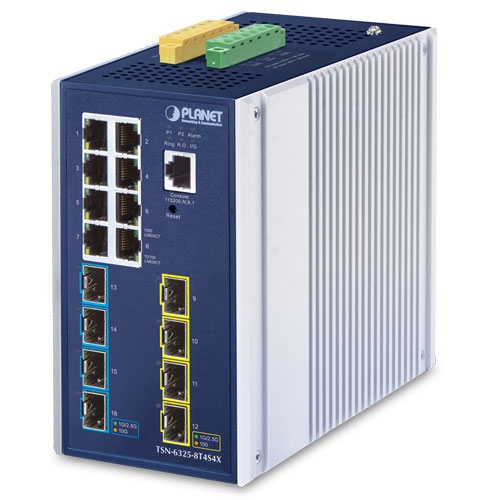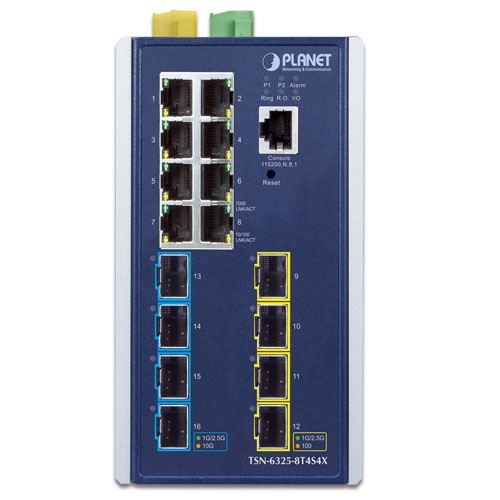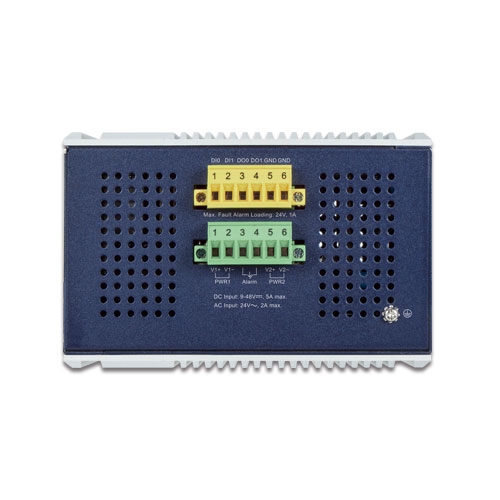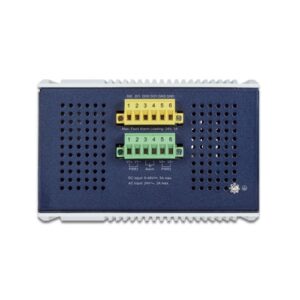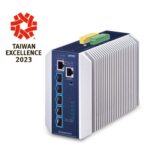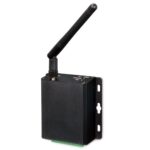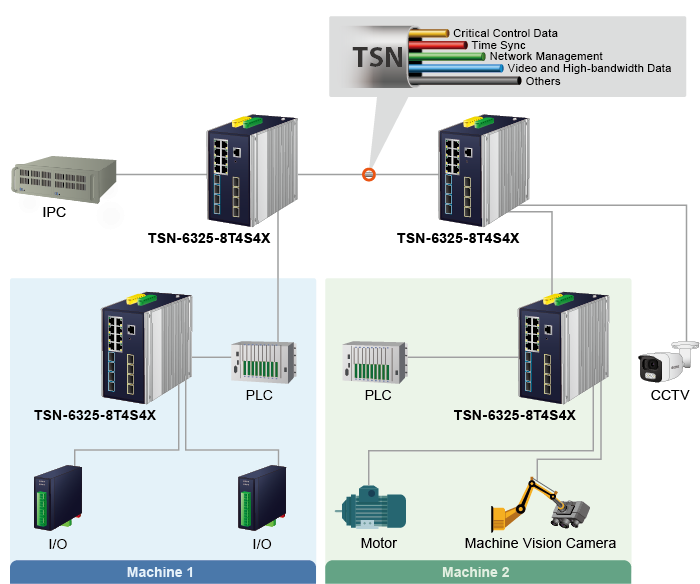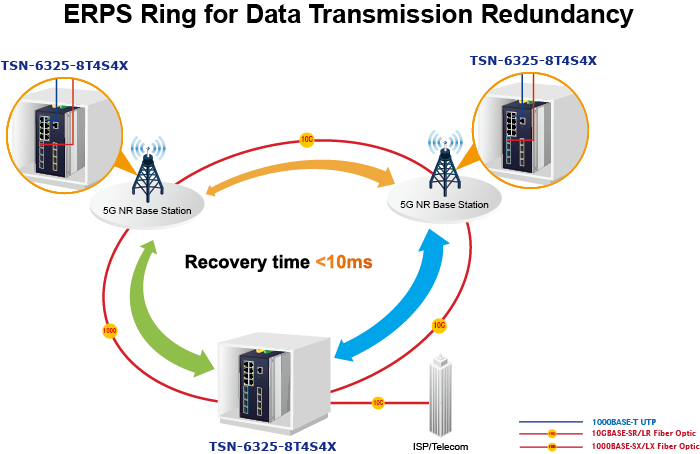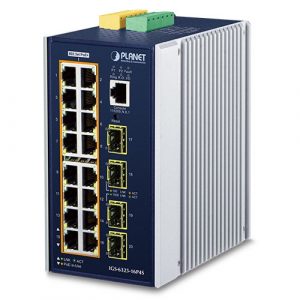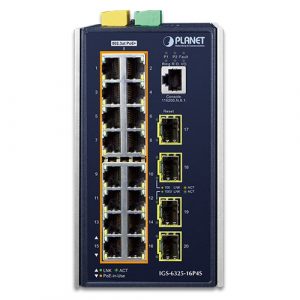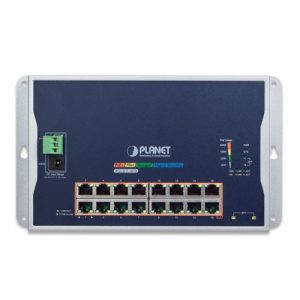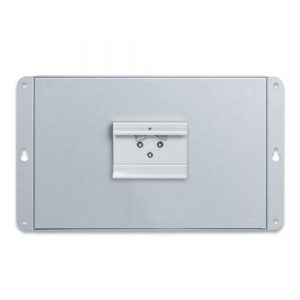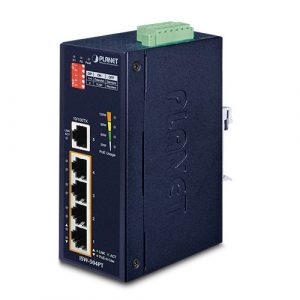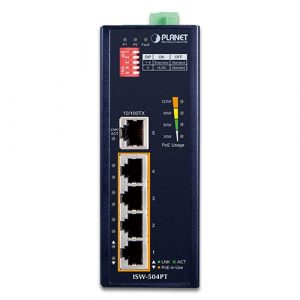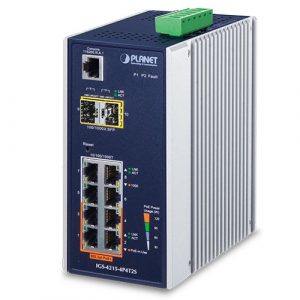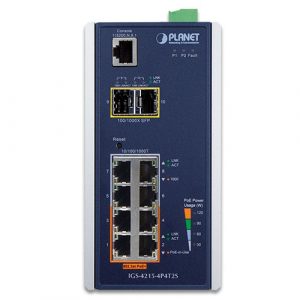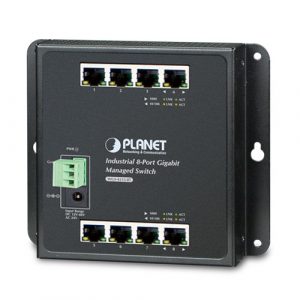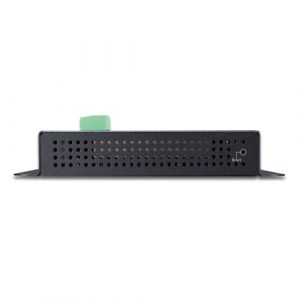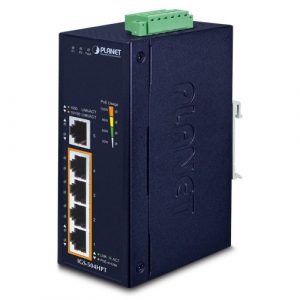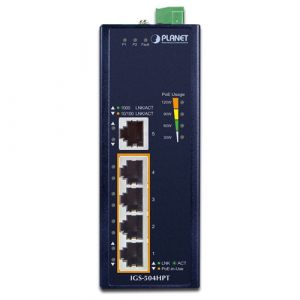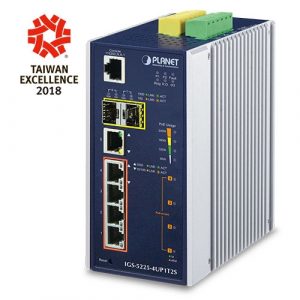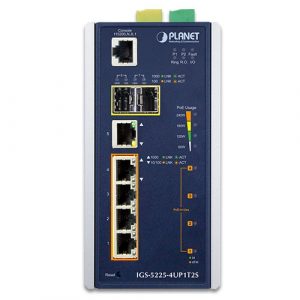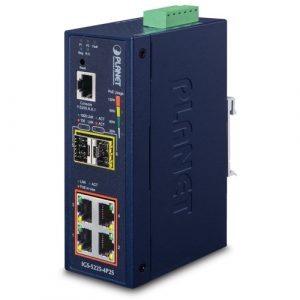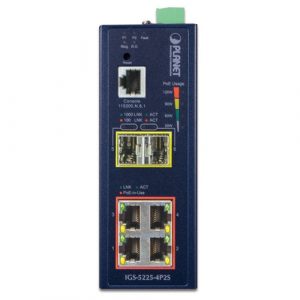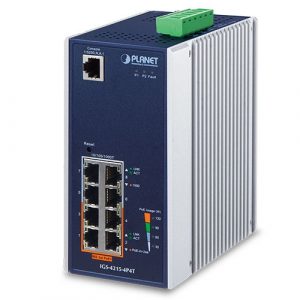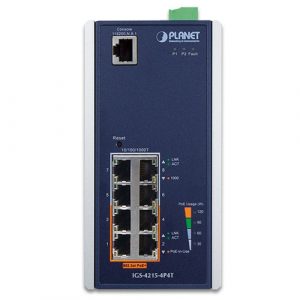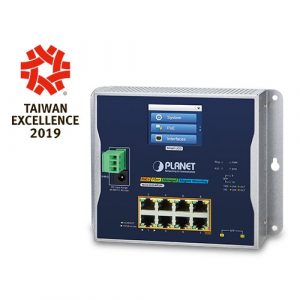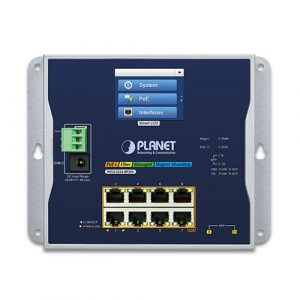TSN-6325-8T4S4X
Industrial L3 8-Port 10/100/1000T + 4-Port 1G/2.5G SFP + 4-Port 10GBASE-X SFP+ Managed TSN Ethernet Switch
- Applicazioni
- SPECIFICHE
- DOWNLOAD
Descrizione
Innovativo switch Ethernet industriale TSN che garantisce la fornitura di dati sensibili al tempo
PLANET TSN-6325-8T4S4X è un nuovissimo switch Ethernet gestito di livello industriale 3 Time-Sensitive Networking (TSN) che dispone di 8 porte RJ45 10/100/1000BASE-T, 4 porte SFP 1G/2,5GBASE-X e 4 porte SFP Le porte SFP+ 10GBASE-SR/LR e il routing IP Layer 3 in un robusto case metallico IP30 per un funzionamento stabile in ambienti pesanti, affrontano tutti i livelli della rete di automazione industriale, dal bus di campo alla dorsale di fabbrica. E garantisce la trasmissione end-to-end del traffico ad alta priorità con una latenza estremamente bassa.
Con le interfacce in fibra da 10 Gbps, il TSN-6325-8T4S4X è in grado di gestire quantità estremamente elevate di dati in una topologia sicura collegata a un backbone industriale, una stazione base 5G NR o un AP wireless Wi-Fi6/6E. Il TSN-6325-8T4S4X è in grado di fornire switch fabric non bloccante e throughput wire-speed fino a 116 Gbps nell’intervallo di temperature da -40 a 75 gradi C. Semplifica notevolmente le attività di aggiornamento della LAN industriale per soddisfare le crescenti esigenze richieste di larghezza di banda.
Un percorso semplificato verso un’infrastruttura compatibile con TSN
PLANET TSN-6325-8T4S4X fornisce comunicazione di rete in tempo reale e a bassa latenza per l’automazione industriale, reti 5G NR, Industria 4.0, streaming video 4K/8K e settore dei giochi VR/AR utilizzando la tecnologia Time-sensitive Networking (TSN) e IEEE 1588 Precision Time Protocol (PTPv2) per la sincronizzazione dell’ora su tutte le porte.
Il TSN-6325-8T4S4X supporta gli standard TSN IEEE necessari per una soluzione di comunicazione completa in tempo reale. Questi includono il profilo IEEE 802.1AS-REV per la sincronizzazione dell’ora, IEEE 802.1Qbv Enhancements for Scheduled Traffic, IEEE 802.1Qbu Frame Preemption, IEEE 802.3br Interspersing Express Traffic (IET), IEEE 802.1Qci per per-stream filtering and policing (PSFP) e Replica ed eliminazione dei frame IEEE 802.1CB per l’affidabilità (FRER) per una ridondanza continua.
Il TSN-6325-8T4S4X elimina la necessità di separare le reti Ethernet della tecnologia dell’informazione (IT) e della tecnologia operativa (OT), fornendo un approccio più diffuso alla sincronizzazione e alla temporizzazione di precisione per gli odierni sistemi di automazione industriale.
1588 Protocollo temporale per reti informatiche industriali
Il TSN-6325-8T4S4X è dotato di IEEE 1588v2 PTP (Precision Time Protocol) con timestamp basato su hardware per la sincronizzazione temporale precisa delle reti e supporto per le modalità Boundary Clock, End to End e Peer to Peer Transparent Clock. È ideale per applicazioni Ethernet di telecomunicazioni e carrier, supportando la fornitura di servizi MEF e soluzioni di timing over packet per IEEE 1588 ed Ethernet sincrona.
Anello ridondante, ripristino rapido per applicazioni di rete critiche
Il TSN-6325-8T4S4X supporta la tecnologia ad anello ridondante e presenta una capacità di ripristino automatico forte e rapida per prevenire interruzioni e intrusioni esterne. Incorpora la tecnologia avanzata ITU-T G.8032 ERPS (Ethernet Ring Protection Switching), il protocollo Spanning Tree (802.1s MSTP) e un sistema di ingresso di alimentazione ridondante nella rete di automazione industriale del cliente per migliorare l’affidabilità del sistema e il tempo di attività in ambienti di fabbrica difficili. In una semplice rete ad anello, il tempo di ripristino del collegamento dati può arrivare fino a 10 ms.
Supporto del routing di livello 3
Il TSN-6325-8T4S4X consente all’amministratore di aumentare comodamente l’efficienza della rete configurando manualmente il routing statico VLAN IPv4/IPv6 Layer 3, le impostazioni RIP (Routing Information Protocol) o OSPF (Open Shortest Path First) automaticamente.
Il RIP può utilizzare il conteggio dei hop come metrica di routing e prevenire i loop di routing implementando un limite al numero di hop consentiti in un percorso dall’origine alla destinazione.
L’OSPF è un protocollo di routing dinamico interno per sistemi autonomi basato sullo stato del collegamento. Il protocollo crea un database per lo stato dei collegamenti scambiando stati dei collegamenti tra gli switch di livello 3, quindi utilizza l’algoritmo Shortest Path First per generare una tabella di routing basata su quel database.
Robuste funzionalità di livello 2
Il TSN-6325-8T4S4X può essere programmato per funzioni avanzate di gestione dello switch Layer 2 come aggregazione dinamica dei collegamenti delle porte, VLAN con tag 802.1Q, VLAN Q-in-Q, VLAN privata, Multiple Spanning Tree Protocol (MSTP), Layer 2 to Layer 4 QoS, controllo della larghezza di banda, snooping IGMP e snooping MLD. Tramite l’aggregazione delle porte di supporto, TSN-6325-8T4S4X consente il funzionamento di un fascio di linee ad alta velocità dotato di più porte e supporta anche il failover.
Gestione efficiente
Per una gestione efficiente, TSN-6325-8T4S4X è dotato di interfacce di gestione console, Web e SNMP.
- Con l’interfaccia di gestione basata sul Web integrata, TSN-6325-8T4S4X offre una funzione di gestione e configurazione semplice da usare e indipendente dalla piattaforma.
- Per la gestione basata su testo, è possibile accedervi tramite Telnet e la porta della console.
- Per il software di monitoraggio e gestione basato su standard, offre una connessione SNMPv3 che crittografa il contenuto del pacchetto ad ogni sessione per una gestione remota sicura.
Soluzione di rete mesh ad alta disponibilità per sistemi Big Data
Per migliorare la tecnologia Ethernet in fibra ottica con funzionalità altamente flessibili, altamente estensibili e facili da installare, TSN-6325-8T4S4X offre una velocità di scambio dati fino a 116 Gbps tramite interfaccia in fibra ottica e la distanza di trasmissione può essere estesa a 120 km .
Il TSN-6325-8T4S4X è dotato di funzionalità di ripristino automatico potente e rapida per prevenire interruzioni e intrusioni esterne. Incorpora ITU-T G.8032 ERPS (Ethernet Ring Protection Switching) nella rete di automazione del cliente per migliorare l’affidabilità e il tempo di attività del sistema. La serie su guida DIN IGS-6325 è la soluzione ideale per data center, fornitori di servizi e telecomunicazioni per creare connessioni ridondanti e stabilire un’elevata larghezza di banda per la server farm Big Data.
| Hardware Specifications | |
|---|---|
| Copper Ports | 8 10/100/1000BASE-T RJ45 auto-MDI/MDI-X ports |
| SFP Port | 4 1000/2500BASE-X SFP portsslot interfaces (Ports -9 to and Port-12) Compatible with 1000BASE-X and 2500BASE-X SFP transceiver |
| SFP+ Ports | 4 10GBASE-SR/LR SFP+ slots Backward compatible with 1000BASE-SX/LX/BX and 2500BASE-X SFP transceivers |
| Console | 1 x RJ45-to-RS232 serial port (115200, 8, N, 1) |
| Reset Button | < 5 sec: System reboot > 5 sec: Factory default |
| Connector | Removable 6-pin terminal block for power input Pin 1/2 for Power 1, Pin 3/4 for fault alarm, Pin 5/6 for Power 2 Removable 6-pin terminal block for DI/DO interface Pin 1/2 for DI 1 & 2, Pin 3/4 for DO 1 & 2, Pin 5/6 for GND |
| Alarm | One relay output for power failure. Alarm relay current carry ability: 1A @ 24V DC |
| Digital Input (DI) | 2 digital input: Level 0: -24~2.1V (±0.1V) Level 1: 2.1~24V (±0.1V) Input load to 24V DC, 10mA max. |
| Digital Output (DO) | 2 digital output: Open collector to 24VDC, 100mA |
| Enclosure | IP30 aluminum case |
| Installation | DIN-rail or wall mounting |
| SDRAM | 2048Mbytes |
| Flash Memory | 64Mbytes |
| Dimensions (W x D x H) | 86 x 135 x 152 mm |
| Weight | 1,597g |
| Power Requirements | DC 9~48V, 5A max. AC 24V, 2A max. |
| Power Consumption | DC input: Max. 16.8 watts/57.3BTU (system on) Max. 38.2 watts/130.3BTU (Full loading) AC 24V input: Max. 21.7 watts/74BTU (system on) Max. 30 watts/102.3BTU (Full loading) |
| ESD Protection | 5KV DC |
| Surge Protection | 6KV DC |
| LED Indicators | System: Power 1 (Green), Power 2 (Green) Fault Alarm (Red) Ring (Green), Ring Owner (Green) DIDO (Red) Per 10/100/1000T RJ45 Port: 1000Mbps LNK/ACT (Green) 10/100Mbps LNK/ACT (Amber) Per SFP Port: 1G/2.5Gbps LNK/ACT (Green) Per SFP+ Port: 1G/2.5Gbps LNK/ACT (Green) 10Gbps LNK/ACT (Amber) |
| Switching Specifications | |
| Switch Architecture | Store-and-Forward |
| Switch Fabric | 116Gbps/non-blocking |
| Throughput | 86.3Mpps@64Bytes |
| Address Table | 32K entries, automatic source address learning and aging |
| Shared Data Buffer | 32Mbits |
| Jumbo Frame | 10K bytes |
| Flow Control | IEEE 802.3x pause frame for full duplex Back pressure for half duplex |
| Layer 3 Functions | |
| IP Interfaces | Max. 128 VLAN interfaces |
| Routing Table | Max. 512 static route entries Max. 3072 routing table entries |
| Routing Protocols | IPv4 RIPv2 IPv4 OSPFv2 IPv6 OSPFv3 IPv4 hardware static routing IPv6 hardware static routing |
| Layer 2 Functions | |
| Port Configuration | Port disable/enable Auto-negotiation 10/100/1000Mbps full and half duplex mode selection Flow control disable/enable Port link capability control |
| Port Status | Display each port’s speed duplex mode, link status, flow control status, auto-negotiation status, trunk status |
| Port Mirroring | TX/RX/Both Many-to-1 monitor Mirror – Remote Switched Port Analyzer (Cisco RSPAN) Supports up to 5 sessions |
| VLAN | IEEE 802.1Q tagged VLAN IEEE 802.1ad Q-in-Q tunneling Private VLAN Edge (PVE) MAC-based VLAN Protocol-based VLAN Voice VLAN IP Subnet-based VLAN MVR (Multicast VLAN registration) GVRP Up to4K VLAN groups, out of 4095 VLAN IDs |
| Link Aggregation | IEEE 802.3ad LACP/static trunk 8 trunk groups with 16 ports per trunk group |
| Spanning Tree Protocol | IEEE 802.1D Spanning Tree Protocol IEEE 802.1w Rapid Spanning Tree Protocol IEEE 802.1s Multiple Spanning Tree Protocol Supports 7 MSTP instances BPDU Guard, BPDU filtering and BPDU transparent Root Guard |
| IGMP Snooping | IPv4 IGMP (v1/v2/v3) snooping IPv4 IGMP querier mode support Supports 255 IGMP groups |
| MLD Snooping | IPv6 MLD (v1/v2) snooping, IPv6 MLD querier mode support Supports 255 MLD groups |
| Bandwidth Control | Per port bandwidth control Ingress: 10Kbps~13128Mbps Egress: 10Kbps~13128Mbps |
| Ring | Supports ERPS, and complies with ITU-T G.8032 Recovery time < 10ms @ 3 nodes Recovery time <50ms @ 16 nodes Supports Major ring and sub-ring |
| Synchronization | IEEE 1588v2 PTP(Precision Time Protocol) PTP Master PTP Slave Boundary clock Peer-to-peer transparent clock End-to-end transparent clock |
| QoS | Traffic classification based, strict priority and WRR 8-level priority for switching: Port number 802.1p priority 802.1Q VLAN tag DSCP/ToS field in IP packet |
| Time-Sensitive Networking Protocols |
High Precision Time Synchronization IEEE1588 (Time Stamping) 802.1AS-Rev gPTP default profile Shapers 802.1Qbv (Time-aware Scheduling) 802.1Qch (Cyclic Queuing and Forwarding) TSN Stream Policing 802.1Qci (Per Stream Filtering and Policing) Redundancy 802.1CB ( Frame Replication and Elimination for Redundancy for seamless redundancy) Also standard Linear and Ring protection Delay Reduction EEE 802.1Qbu Frame Preemption IEEE 802.3br Interspersing Express Traffic (IET) |
| Security Functions | |
| Access Control List | IP-based ACL/MAC-based ACL ACL based on: MAC Address IP Address Ethertype Protocol Type VLAN ID DSCP 802.1p Priority Up to 512 entries |
| Security | Port security IP source guard, up to 512 entries Dynamic ARP inspection, up to 1K entries Command line authority control based on user level Static MAC address, up to 64 entries |
| AAA | RADIUS client TACACS+ client |
| Network Access Control | IEEE 802.1x port-based network access control MAC-based authentication Local/RADIUS authentication |
| Management | |
| Basic Management Interfaces | Console; Telnet; Web browser; SNMP v1, v2c |
| Secure Management Interfaces | SSHv2, TLSv1.2, SNMPv3 |
| System Management | Firmware upgrade by HTTP protocol through Ethernet network Configuration upload/download through HTTP Remote Syslog System log LLDP protocol NTP PLANET Smart Discovery Utility PLANET CloudViewer app |
| SNMP MIBs | RFC 1213 MIB-II RFC 1493 Bridge MIB RFC 1643 Ethernet MIB RFC 2863 Interface MIB RFC 2665 Ether-Like MIB RFC 2819 RMON MIB (Group 1, 2, 3 and 9) RFC 2737 Entity MIB RFC 2618 RADIUS Client MIB RFC 2863 IF-MIB RFC 2933 IGMP-STD-MIB RFC 3411 SNMP-Frameworks-MIB RFC 4292 IP Forward MIB RFC 4293 IP MIB RFC 4836 MAU-MIB IEEE 802.1X PAE LLDP |
| Standards Conformance | |
| Regulatory Compliance | FCC Part 15 Class A CE: EN55032 EN55035 |
| Stability Testing | EC60068-2-32 (free fall) IEC60068-2-27 (shock) IEC60068-2-6 (vibration) |
| Standards Compliance | IEEE 802.3 10BASE-T IEEE 802.3u 100BASE-TX/100BASE-FX IEEE 802.3z Gigabit SX/LX IEEE 802.3ab Gigabit 1000T IEEE 802.3ae 10Gb/s Ethernet IEEE 802.3bz 2.5GBASE-X IEEE 802.3x flow control and back pressure IEEE 802.3ad port trunk with LACP IEEE 802.1D Spanning Tree Protocol IEEE 802.1w Rapid Spanning Tree Protocol IEEE 802.1s Multiple Spanning Tree Protocol IEEE 802.1p Class of Service IEEE 802.1Q VLAN tagging IEEE 802.1X Port Authentication Network Control IEEE 802.1ab LLDP IEEE 802.3ah OAM IEEE 802.1ag Connectivity Fault Management (CFM) IEEE 802.1AS – Timing and Synchronization for Time-sensitive Applications IEEE 802.1Qbu Frame Preemption, IEEE 802.3br Interspersing Express Traffic (IET) IEEE 802.1Qci Per-Stream Filtering and Policing (PSFP) IEEE 802.1Qbv Enhancements for Scheduled Traffic IEEE 802.1CB Frame Replication and Elimination for Reliability (FRER) RFC 768 UDP RFC 783 TFTP RFC 791 IP RFC 792 ICMP RFC 2068 HTTP RFC 1112 IGMP v1 RFC 2236 IGMP v2 RFC 3376 IGMP v3 RFC 2710 MLD v1 RFC 3810 MLD v2 RFC 2328 OSPF v2 RFC 5340 OSPF v3 RFC 2453 RIP v2 ITU-T G.8032 ERPS Ring |
| Environment | |
| Operating | -40 ~ 75 degrees C |
| Storage | -40 ~ 85 degrees C |
| Humidity | 5 ~ 95% (non-condensing) |




